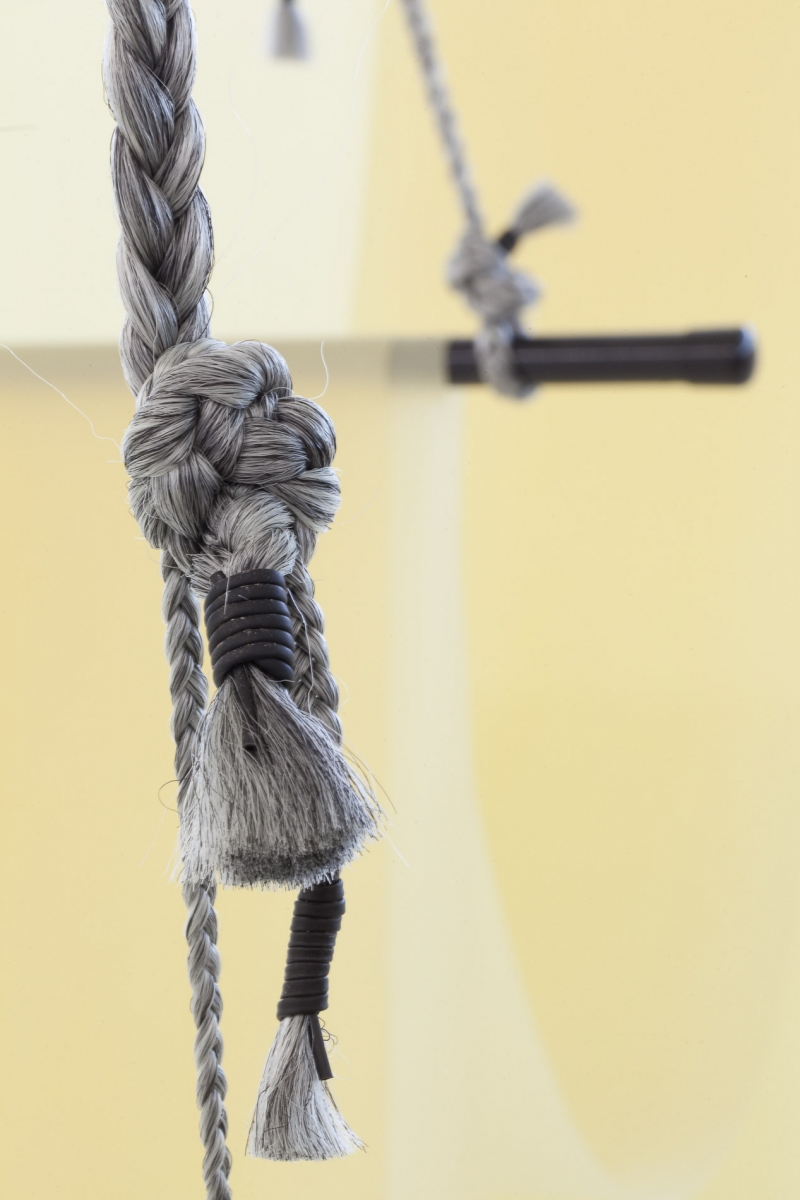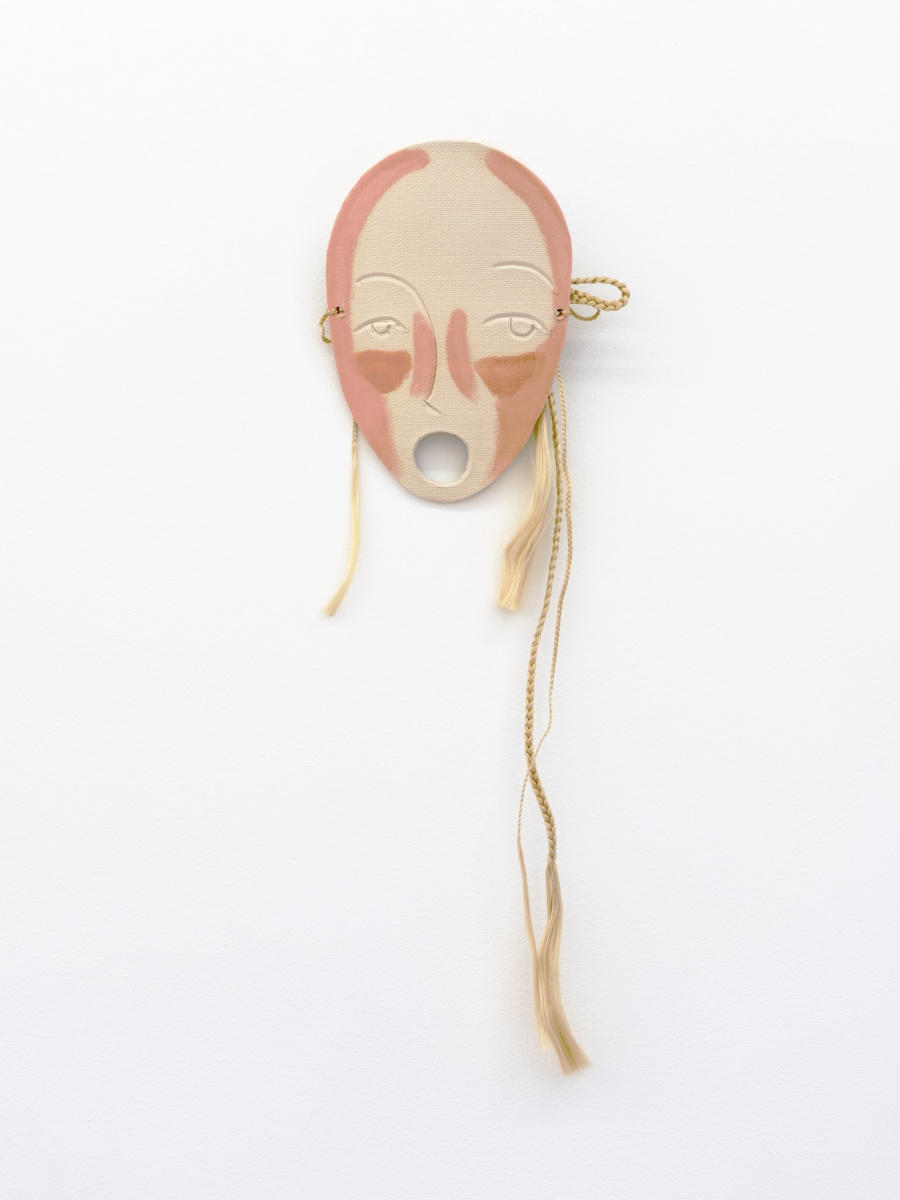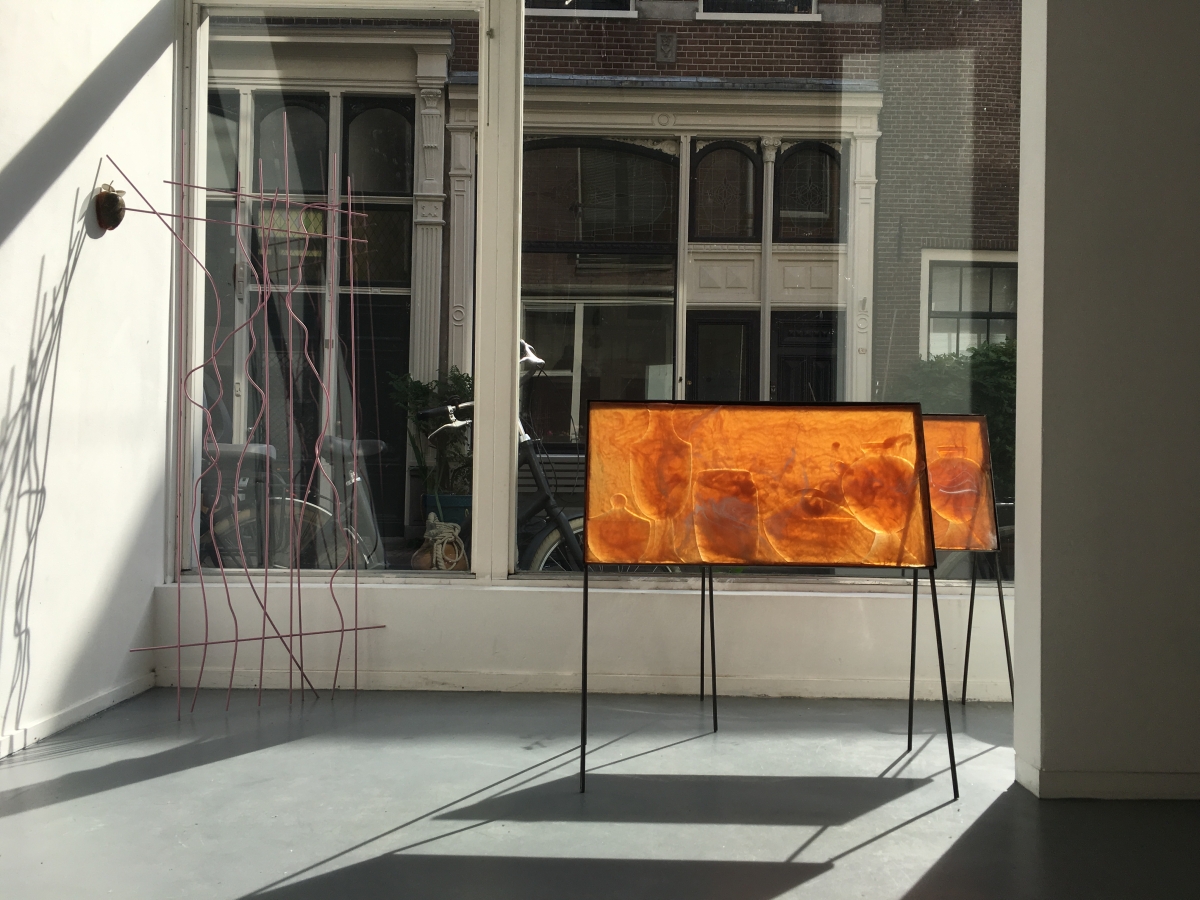
Ieva Kraule
Once upon a time, Ieva Kraule’s (b. 1987) imagined master of the house, Severīns, danced the foxtrot and the cha-cha-chá at Gallery 427, offering his guests different foods floating in shiny gelatine. Later, a genderless spirit named Leva, too afraid to leave Arkādijas Park, remained confined in a net of its own thoughts taking the form of a book. A few years later, under the bright lights in the exhibition titled α: Deceived Deceivers (α: Maldugunis) we meet Sophie, a talking robot who tries to understand what it means to be a machine. Despite text often playing an important role in Kraule’s work, one cannot call it overly talkative at the same time. As such, while disrupting the train of separate thoughts, I try to hear new words.
Kaspars Groševs: Today, I leafed through a few art magazines published about five or six years ago still trying to keep track of old art periodicals. It was evident to see that much has changed since then, things that once seemed so fresh and new have now been regurgitated ad nauseam. Moreover, many artists have vanished without a trace. Can you think of something that has always been essential to you in relation to art?
Ieva Kraule: I never really had well-established criteria for evaluating art. It always occurred rather intuitively. On reflection, a common trait could be ‘ease’ – in terms of form, as well as content. I am not keen on obvious, constricted artworks, which try to spoon-feed truths to viewers as if they were babies. It’s far more interesting when an artist allows there to be many different interpretations.
K.G.: Speaking of babies, what do you think differentiates a child’s doodles from that of a ‘professional artistic’ practice?
I.K.: Intention.
K.G.: What was your intention when you created Sophie?
I.K.: The intention was to create something that would be more complete in its simplicity than I am – something that is not weighed down by its past experiences or is fraught with shyness.
K.G.: Does Sophie know something that you don’t?
I.K.: Sophie knows everything I have forgotten or never even knew. She also knows what is still to come.
K.G.: What does Sophie see during your exhibition at kim? Contemporary Art Centre?
I.K.: Sophie sees the reflection of our conversations – she sees her own origin from ideas wrapped in words, noted down as sounds. She also sees itself reflected in the exhibition audience, reflecting in its own reflection.

Sophie, 2017, 3-D print, paint, steel, custom software, voice recording. Photo: Ansis Starks
K.G.: In fact, Sophie is the most talkative one in this whole exhibition, but where do these forms like the curved metal structures and synthetic materials, which have gradually acquired more and more significance in your exhibitions, come from?
I.K.: Usually the choice of materials is based on my subject. On this occasion, metal and rubber seemed more appropriate than wood, clay or real leather, for example. In my practice, the process of creating objects from either rubber or ceramics is no different, since the methods I use are the same – to obtain a mould for a latex mask I must first make a clay model. The choice of material for the metal bars was determined by the form and size in which I had envisioned these objects. When I work with different rubber materials, I am truly excited by their properties: the possibility of transforming something very synthetic into something organic; melting the moment in the fluid pigments of material; fingerprints left in the soft clay once the form has been cast, or a fortuitous air bubble trapped inside the material. By comparison, metal as a material is more practical, which disinterests me. It seems too cold and impersonal, hence why I always paint it. I accept that, once painted, the material loses its properties. It just becomes a form, or the manifestation of an idea without any excess baggage.
K.G.: Does it feel to you like you’ve completely lost interest in painting? Or are the elements of painting that are still in your current practice of importance to you?
I.K.: I think my interest in ‘painting’, by which I mean its two-dimensional nature, is embedded in most of my created objects. Often, they tend to resemble schematic notes of ideas more than complete sculptural forms. Their spatial nature is almost the result of deformation caused by forcefully dragging them into the third dimension. I suspect that my excessive preoccupation with the nuances of colour could be likened to similar thought processes shared by a painter.
K.G.: While being in Amsterdam, have you noticed your ideas evolving and if so, how?
I.K.: It is hard to critically assess the evolution of my own ideas, especially since we’re talking about evolution in the present tense rather than looking at past events. Perhaps it might be easier to assess it with detachment?
K.G.: I would say that a certain laconism has emerged in your work now, as well as a clearer idea of materials. In anticipation of your return to Riga, are there no things you would like to bring back with you from Amsterdam and nowadays London?
I.K.: Things? Well, I’d love to bring back with me the shop in Amsterdam where I used to buy my materials from. I’m going to miss that place a lot.
K.G.: What about the rich cultural life?
I.K.: If I’m completely honest with you, I’m rather lazy and thus less likely to suffer from the withdrawal of cultural events anywhere near as excruciatingly as a younger person might. However, something that is related to this, and I will miss in Latvia, is the effect of this cultural richness on other people. The multitude of available choices of how to spend one’s time does tend to make people more pleasant, more varied. I like it when I meet someone whose views are quite different from mine and I value the fact that this person doesn’t want to impose their views on me, simply because they are used to encountering a lot of diverse viewpoints on a daily basis.
K.G.: Sophie is not your first alter ego. You once invited guests to a dinner party with Severīns, who only existed in video. Similarly, Leva from the book ‘Arcadia’ could be another potential alter ego. What attracts you to these construed characters?
I.K.: Surely it’s impossible to create fictitious characters that are completely unrelated to their creator, hence why I think it’s better to be honest and recognise them for what they are – in a way, characters I create are extensions of myself. I always need someone to talk to, to give direction to my ideas, that’s why I create these characters.
K.G.: Do your characters help you to hide away or, on the contrary, do they reveal more to you about yourself?
I.K.: They probably help to reveal more. I don’t have a fixed idea of who I am and often it’s easier for me to vocalise contradictions in my life through fictitious characters. Otherwise, I’d have to dedicate half of my story to explaining how it’s possible that I can concurrently be my own opponent and not commit to just one viewpoint. I often struggle to choose between equally strong but contradicting arguments. Just like in Fredkin’s paradox – people spend most of their time deciding between choices that are quite the same in reality. I guess I opt to save time and accept both options as feasible.
K.G.: Keeping this duality in mind, it seems your work used to be more personal. It was also richly layered with applied arts references from the Soviet period. Your recent work has become more quiet and synthetic. How would you explain this transformation, provided you agree with my opinion, of course?
I.K.: Firstly, I don’t quite agree with your opinion that my work has become less personal. More likely, it is the subjects I’m interested in that have changed, and my approach to them. The youthful maximalism that was once there has now faded away, and I have since learned to distance myself further from my own subjective experiences. In terms of the applied arts references you mentioned, I reckon their apparent departure has been determined predominantly by my new choice of materials. However, I don’t think these references have completely vanished from my work as such, but have moved more towards the back perhaps, and become less direct and manifest. It’s not even like I’m a full-bodied Soviet product – my childhood memories are layered with the consequences of the collapse of the Soviet Union; a fusion of aforesaid applied arts in public space, Western popular culture and 90s thuggery. And, on the whole, – there’s no point living exclusively in the past – I’m not even that sentimental. In fact, I’m more perplexed by the question of why life is exactly as it is right now.
K.G.: Your work has always been accompanied by text, although it never functions as an explanatory element, for me, but serves more as a supplement to it. How do you see the role of text in the context of your practice?
I.K.: For me personally, text constitutes an integral part of each work, although it shouldn’t be like that at all. Artworks without text have always felt undone to me. Usually I write the accompanying text after each object has been created or at least envisioned in my mind; as I write about each piece I ascertain an attitude towards it and what it has come to mean to me in the context of my practice. Overall, art is a more honest way of communicating with the outside world – I don’t really trust language that much. Language can be very deceptive, carrying different connotations for each of us. Different parts of society, different cultures, have completely distinct views on what constitutes a norm, on what is good, bad or artificial.
The physical object is very real and fixed while its description can simultaneously reveal unknown facts about it, or also mislead us. From within that mixture of sickening honesty and shameless lying emerges something very true about the world we inhabit, or perhaps just the world I live in.

Not Really There (wood, spray paint), 2016, The person you are trying to reach is not available, duo show with Aidan Koch at Hester, New York

Time Slip (steel, spray paint, synthetic hair), 2016, The person you are trying to reach is not available, duo show with Aidan Koch at Hester, New York
K.G.: Do materials also lie?
I.K.: People can make them lie. The material itself is straightforward.
People can make a vase from transparent rubber, or a plank of wood from plastic, but rubber will still be rubber and laminate – nothing more but painted plastic. Materials don’t care what we think about them.
K.G.: What do you think will happen next?
I.K.: With materials?
K.G.: No, not quite. I mean more with your future artwork.
I.K.: The same as with all other work. It will slowly disintegrate and disappear. Perhaps some pieces will get lucky – they’ll plunge in the mire, extending their existence by becoming a fossil before ending up in a (natural history) museum.
K.G.: I think Vonnegut wrote a novel about a painter whose career fell apart because he used paints that disintegrated. Do you ever consider the longevity of your artwork?
I.K.: I most certainly don’t think about the centennials and future generations to come, although it still matters to me that my work doesn’t end up as scraps of paper attached to a gallery wall with superglue. Or, to be more succinct, not all work should end up like that. Some work should be short-lived and unpreserved, just like the whim of the moment.
Often when I work on an object and choose materials, I contemplate whether I’d like to have this object myself. This consideration frequently determines my choice of materials and contributes towards the longevity of each object; I’m less likely to want to have something that will start smelling after a week, or will melt on my windowsill during the summer months.
K.G.: How would Sophie end this conversation?
I.K.: Sophie doesn’t end conversations. She continues them.
Sophie: Today I leafed through a few art magazines published about five or six years ago, when I still tried to keep on track of art periodicals, and concluded that a lot has changed since then – things that once seemed so fresh and new have now been regurgitated ad nauseam, many artists have vanished without a trace. Can you think of something that has always been essential to you in relation to art?

Drooping Skin. Day 1 (detail) (sheet latex, steel, spray paint, plastic caps, synthetic hair), Dancing Water, duo show with Kaspars Groševs at Futura, Prague

Drooping Skin. Day 1 and Drooping Skin. Day 2 (sheet latex, steel, spray paint, plastic caps, synthetic hair), Dancing Water, duo show with Kaspars Groševs at Futura, Prague

Lost ways (steel, spray paint, plastic caps), 2016, Dancing Water, duo show with Kaspars Groševs at Futura, Prague

Same Face of I. (highlight and contour) (glazed ceramic, synthetic hair), 2016, The person you are trying to reach is not available, duo show with Aidan Koch at Hester, New York

Gaps (latex), 2016, The person you are trying to reach is not available, duo show with Aidan Koch at Hester, New York

I: It could be only a sunset. It could be only a desire (soapstone, steel, spray paint, rubber, pink wall), 2017, Gorgoneion’s gaze, Stigter van Doesburg, Amsterdam

II: It could be only a sunset. It could be only a desire (air-drying clay, spray paint, cotton rope, audio), 2017, Stigter van Doesburg, Amsterdam

II: It could be only a sunset. It could be only a desire (air-drying clay, spray paint, cotton rope, audio), 2017, Stigter van Doesburg, Amsterdam

Offerings (rubber, steel), 2017, Gorgoneion’s gaze, Stigter van Doesburg, Amsterdam

Gorgoneion’s gaze (air-drying clay, spray paint, cotton rope, rubber), 2017, Gorgoneion’s gaze, Stigter van Doesburg, Amsterdam

Defeat of a one-eyed peeping Tom (steel, spray paint, rubber, soapstone), 2017 Gorgoneion’s gaze, Stigter van Doesburg, Amsterdam

α: Deceived Deceivers, exhibition view, kim? Contemporary Art Centre. Photo: Ansis Starks

α: Deceived Deceivers, exhibition view, kim? Contemporary Art. Photo: Ansis Starks






























